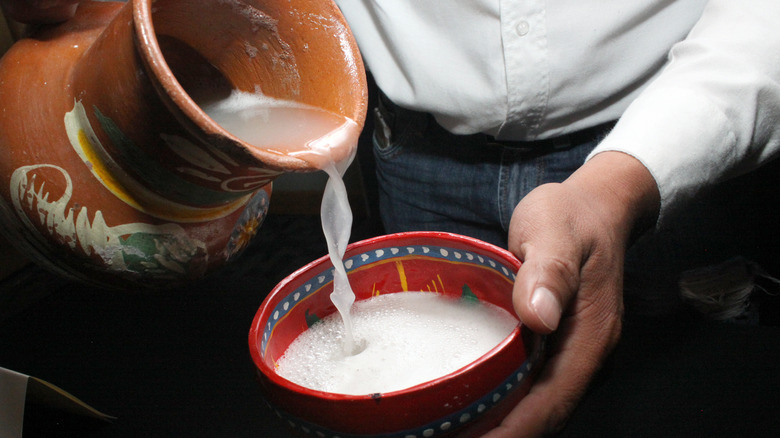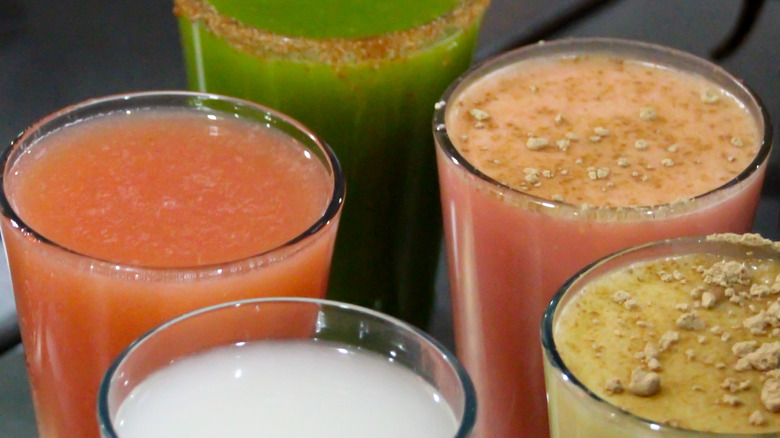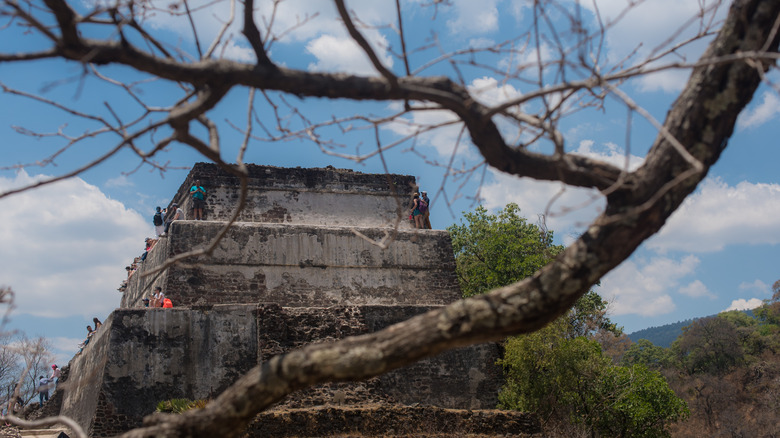Pulque: The Ancient Mesoamerican Beverage Made From Agave
Let us introduce you to one of the original national drinks of Mexico, and no we're not talking about margaritas. Pulque originates from the days of the Aztecs in Central Mexico and is technically considered an alcoholic drink, though it works a little differently (we'll get to that later). Considered to be the Aztec drink of the gods, per Agave Cocina, this beverage has a milky white appearance coupled with a distinctive acidic smell. It comes from the sap of maguey plants, also known as agave. This probably rings a bell because two present-day favorites, tequila and mezcal, also come from the agave plant, and some would consider pulque the grandfather of modern tequila. But one of the key differences between tequila and pulque is that tequila is distilled, while pulque is fermented. Mexperience says tequila also involves cooking the raw plant matter before distilling it, while pulque ferments it raw.
The flavor of pulque is unlike anything else, one could argue you'd have to try it yourself to truly understand. It's exceedingly rare to find in the United States but it's abundant in Mexico to this day. The next time you take a trip there, consider skipping the margarita and give pulque a try. It has a taste and texture similar to kombucha, if not a bit thicker, and it comes in two main forms, per BBC: plain and curado, which is sweetened with other flavors, usually fruit.
Pulque hits a little different than other alcoholic drinks
While you might find pulque described as an alcoholic drink — and perhaps technically it is, though the ABV is usually in the low single digits — it doesn't affect your body the same way a beer would. According to BBC, you can sit and drink pulque practically for hours on end without feeling a buzz. It's only when you get up to leave your seat that you start to feel its effects on your body, though your mind apparently remains relatively clear. However, it does contain a certain amount of alcohol, similar to a beer, so it's reasonable to assume you'd feel some sort of effects if you tossed a few down the hatch.
In Mexico, you can enjoy pulque in bars called pulquerias, and due to the nature of the beverage's short shelf life, it's pretty much always made fresh. Though the locals are used to the almost buttermilk-like flavor of plain pulque, it pairs nicely with all sorts of complementary flavors to take some of the edge off. Tropical fruits like pineapple, mango, and guava are common but there are more unique flavors like tomato and even oyster, according to Matador Network.
Pulque's connection to indigenous culture
Pulque is more than just a unique beverage or experience for you to have in Mexico, it has roots that reach back all the way to ancient Aztec culture in central Mexico. The frothy white elixir was once considered to be a sacred drink, dating to at least colonial times, per Parts Unknown. Known as the drink of the gods, its truly special effect on the body was considered to be both "eye-opening" and "comforting" simultaneously, per Serious Eats. The liquid itself was thought to represent the divine blood of the Aztec goddess Mayahuel, per Atlas Obscura.
The liquid was frequently used for herbal and medicinal purposes in ancient times, whereas now it's enjoyed mostly out of respect for the culture and for the bodily effects. When pulque was more mainstream, there were thousands of pulquerias scattered throughout Mexico, but the number has diminished to less than 100, according to Atlas Obscura. It is now up to the younger generation and their re-ignited interest and passion for Mexican culture and history to keep this tradition alive.


